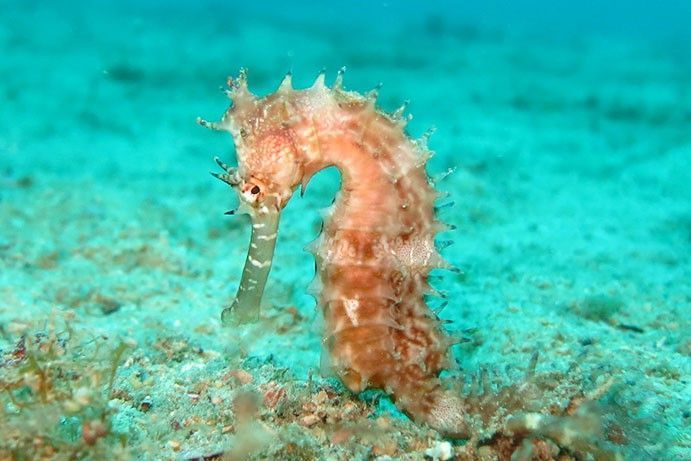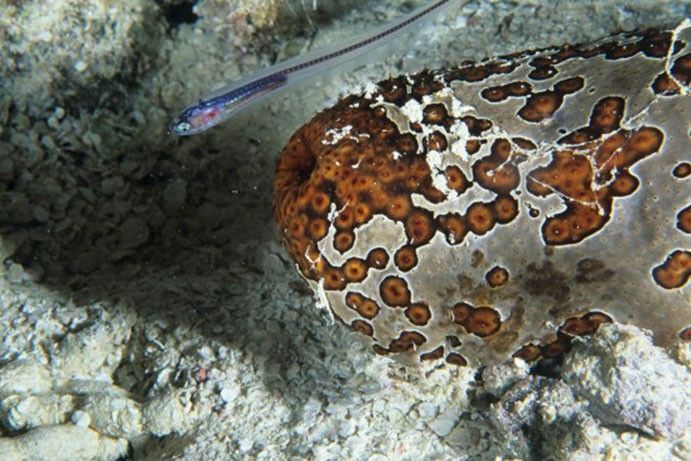7 weird and wacky marine animals you'll find in Queensland
List
By Ariana Potamianakis
Given we’ve explored less than 5% of the ocean to date (which is minuscule when more than 70% of our planet is covered by it), it’s safe to say there’s a lot going down in the underwater world that we are yet to discover.
Heck, even creatures and places we do know about continue to surprise us, including the Great Barrier Reef!
From bum-breathing reptiles to fish that change gender, here are 7 weird and wonderful marine animals and encounters you’ll find in Queensland.
Mer-Dugong?

Photo by Tourism Australia via Facebook
Fun fact: The myth of mermaids is actually said to have come from sightings of dugongs many moons ago when pirates mistook their tails and smooth forms for something more human-like.
Nowadays, these gentle giants are more widely known as sea cows, not just because of their curvaceous appearance but because, like their land equivalent, their diet consists of grazing on (sea)grass all day long.
Where you’ll find them: These slow-moving marine mammals can be found all along the coast of Queensland in shallow protected bays, mangrove channels and along the inside edge of large inshore islands. Some hot spots include:
- The Hinchinbrook Channel off the coast of Cardwell
- From the small beach town of Claireview, 1.5 hours from Mackay (sightings are so common that in 1997 the town was established as a bonafide dugong sanctuary)
- In the protected waters of the Pumicestone Passage in the Bribie Island Recreation Area
- Off Dugong Beach on Whitsunday Island
Who’s your daddy?

They’re beautiful, ancient and propel themselves along with a swish of their tail, but surprisingly it’s the male seahorse that gestates the eggs and gives birth to the young. How’s that, ladies?
And unlike other serial aquatic daters – like dolphins – these guys are monogamous, meaning once they find that special someone, they’re mates for life.
Where you’ll find them: In sheltered areas like seagrass beds, estuaries, and mangroves, and throughout the coral gardens of the Great Barrier Reef.
Bottom feeder

The rather intrusive Pearl Fish is lucky that it’s so slender – it swims up the backside of the sea cucumber and lives in its body cavity during the day.
But the derriere quirks don’t end there, with the Pearl Fish’s own backside located right near its throat.
Where you’ll find them: Whenever you come across a sea cucumber on the Great Barrier Reef, chances are there’s a Pearl Fish residing somewhere in its body, waiting for night to fall before they emerge to feed on small crustaceans (they’re also fans of other invertebrates such as clams, oysters and starfish).
Dad, is that you?

There’s plenty of gender-bending going on in the Great Barrier Reef! If Nemo’s mother had really died in the wild, his dad would have gone through a sex change as the leader of the school is always female.
If you’re scratching your head thinking “What?”, this is because all clownfish are born as males, so when the dominant female dies, one must turn themselves into a female in order to run the pack (but once the change is made, they can never go back).
Where you’ll find them: Finding Nemo is a cinch in Queensland because he – or she – is found all over the Great Barrier Reef!
Turtle power

When people think of turtles in Queensland, most tend to conjure up images of baby hatchlings scuttling across our shores or a friendly passerby whilst snorkelling and diving on the Great Barrier Reef.
Inland, however, not only can you still find these majestic beauties, but there are also several species of freshwater turtles known as ‘Bum-Breathing Turtles’ that can absorb air from water taken in through their behind. #truestory
For more turtle-y awesome facts check out this post.
Where you’ll find them: Although it’s rare to spot our bum-breathing friends in the wild, six of the world’s seven turtle species call the Great Barrier Reef home, so it’s really not hard to run into one!
For a guaranteed sighting, check out this round-up of the best turtle locales on the Southern Great Barrier Reef.
Spawning in spring

Photo by The Great Barrier Reef via FB
Each year around October to December, the Great Barrier Reef plays host to the biggest orgy in the world when the corals ‘broadcast spawn’ in synchronicity so the male and female gametes can meet and produce new coral.
It’s not as graphic as you might think, though, with the event resembling more of an underwater snowstorm as millions of tiny cells are released from living coral, which then fertilise to form larvae which eventually settle on the reef to form new coral colonies.
Where you’ll find it: Coral spawning is one of the most coordinated natural events on the planet, going down across the Great Barrier Reef each year at roughly the same time (between late spring or early summer) when water temps and moon cycle aline.
Witness this motion in the ocean for yourself on a coral spawning tour in Tropical North Queensland with Tusa Dive, Cairns Dive Adventures, and Deep Sea Divers Den (also located in Cairns).
The Great Barrier Reef celebrity

Have you met Gavin?
He’s the resident bluebarred parrotfish at Green Island who can’t help photobombing almost every photo on their Seawalker experience tour, not that anyone minds (just look at that cute beaky smile!).
Speaking of his smile, it’s where the species got their name in the first place, with teeth and jaws that have been fused together into a parrot-like beak.
Where you’ll find him: If you want to snap a selfie with the local superstar, don a helmet and get steppin’ along the ocean floor stat. But Gavin’s just one of several different species of parrotfish found on our Great Barrier Reef and, thanks to their defining grin and colourful aesthetic, are easily (and frequently) spotted.
